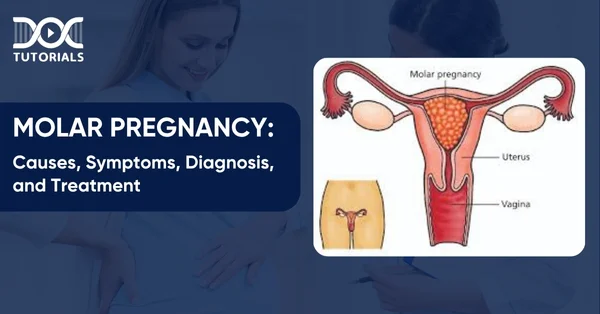Molar Pregnancy: Causes, Symptoms, Diagnosis, and Treatment

Molar pregnancy is an abnormal condition which is characterised by the excessive growth of the uterine cells (trophoblasts), instead of a fetus. This condition can lead to serious complications if left untreated. That is why it is essential to be aware of the presenting symptoms to prevent complications and treat the conditions at an early stage.
Molar pregnancy is also a crucial topic for the NEET PG examination. Hence, every medical student must be familiar with the signs and symptoms, causes, diagnostic methods, and treatment options available to excel in the exam.
This article covers all the major aspects of molar pregnancy, such as its causes, signs and symptoms, diagnostic approach, and treatment modalities. Keep reading to get a detailed insight.
What is Molar Pregnancy?
A molar pregnancy is an uncommon complication of pregnancy characterised by the abnormal growth of trophoblast cells. These trophoblasts then grow to form the placenta. Molar pregnancies can be classified broadly into 2 categories:
- Complete Molar Pregnancy
A molar pregnancy is said to be complete in case the placenta gets inflamed and forms hydatid cysts (fluid-filled cysts). There is no presence of any fetus in this condition.
- Partial Molar Pregnancy
In this condition, the placenta contains both normal and diseased tissues. In this condition, there might be a fetus present, but it becomes impossible for it to survive. Usually, this fetus is miscarried in the first trimester.
What Causes Molar Pregnancy?
An egg that is abnormally fertilised leads to a molar pregnancy. Human cells should have 23 pairs of chromosomes. When fertilisation is normal, one of each pair of chromosomes comes from the father and the mother.
In an entire molar pregnancy, a single sperm or two fuses with an egg. The mother’s egg chromosomes are either missing or non-functional, whereas the father’s chromosomes are doubled; however, there are no chromosomes from the mother.
When it comes to incomplete molar pregnancy, the mother’s chromosomes are actually present, but the father contributes two sets of chromosomes. Now, the embryo has 69 chromosomes instead of the usual 46. This is the most probable event when two sperm fertilise one egg, giving a duplicate of the father’s genes.
What are the Symptoms of Molar Pregnancy?
Molar pregnancy can present with several characteristic symptoms, such as:
- Vaginal Bleeding
The bleeding usually occurs in the first trimester of the pregnancy.
- Expulsion of Cysts
One can notice grape-like cysts coming out of the vagina.
- Severe Nausea and Vomiting
A patient of molar pregnancy can also present with multiple episodes of vomiting and a constant urge to vomit.
- Miscellaneous Symptoms
Other symptoms may include preeclampsia, abnormally high levels of hCG (human chorionic gonadotropin), and anaemia.
What is the Diagnostic Approach for Molar Pregnancy?
A medical practitioner suspecting a molar pregnancy can order blood tests and an ultrasound. In early pregnancy, a sonogram can involve a wand-shaped device inserted into the vagina.
By at least 8 to 9 weeks of gestation, a complete molar pregnancy ultrasound can identify:
- No embryo or fetus
- No amniotic fluid
- A massive cystic placenta that almost occupied the uterus
- Ovarian cysts
On the other hand, a partial molar pregnancy ultrasound can disclose:
- A fetus that is smaller than normal
- Lower amniotic fluid
- Unusual appearance of the placenta
After diagnosing a molar pregnancy, a healthcare provider can screen for other health problems, such as:
- Hyperthyroidism
- Anemia
- Preeclampsia
What is the Treatment for Molar Pregnancy?
A molar pregnancy must not be permitted to progress. To avoid complications, the affected placental tissue needs to be excised. Treatment is usually a combination of the following procedures:
- Dilation and Curettage (D&C)
This procedure removes molar tissue from the uterus. The patient lies on a table on their back with their legs in stirrups. Soon, they will be medicated to be numb or put to sleep. After the cervix has been dilated, the practitioner suctions the uterine tissue with a suction device. This process for molar pregnancy is typically done in an ambulatory surgery facility or a hospital.
- Removing the Uterus
This is done only in rare cases, if there is still a risk of gestational trophoblastic neoplasia (GTN) and future pregnancy is not commonly desired.
- Follow-Up of hCG
Once the molar tissue has been removed, a caregiver still monitors the hCG level until it falls. An elevated blood level of hCG that is persistent will require further treatment. After treatment, a doctor can check hCG levels every six months to confirm that no molar tissue remains.
In GTN patients, after chemotherapy is completed, hCG levels are checked for an entire year. Since hCG levels can also increase in a normal pregnancy, a clinician would recommend waiting for 6 to 12 months before trying for another pregnancy. An alternative method of birth control might be recommended by the clinician.
What are the Various Complications of Molar Pregnancy?
The most common complication of molar pregnancy is the retention of bits of the diseased placenta that leads to a condition called persistent gestational trophoblastic neoplasia (GTN). The association of GTN is more common with complete molar pregnancy as compared to partial molar pregnancy.
GTN is typically characterised by the presence of high levels of hCG (human chorionic gonadotropin) in the blood, even after the removal of the molar tissues. These high levels of hCG can lead to another aggressive form of cancer, called choriocarcinoma.
Choriocarcinoma can easily metastasise to other organs, leading to organ failure. Both of these conditions are usually treated with chemotherapy primarily.
FAQs About Molar Pregnancy
- Is it possible for a baby to survive through a molar pregnancy?
No. This kind of pregnancy usually gets terminated in the first trimester only.
- What symptoms does a mother have in a molar pregnancy?
The mother can present with dark brown or bright red bleeding from the vagina, with expulsion of cysts.
- Does a molar pregnancy fetus have a heart sound?
No. Usually, there are no fetal heart sounds and movements detected in the case of a molar pregnancy.
- What is the removal technique for molar pregnancy?
The most commonly preferred modality of surgical intervention for a molar pregnancy is dilation and evacuation.
- How does molar pregnancy occur?
The simple cause for a molar pregnancy is the abnormality in the fusion of the egg and sperm.
Conclusion
Molar pregnancy is a condition that warrants immediate intervention. It is extremely crucial to look out for the signs and symptoms. Being aware of the symptoms, diagnostic methods and treatment options available can help achieve the best outcome and prevent complications.
Molar pregnancy is an essential topic for medical students preparing for the NEET PG examination. With DocTutorials, you can access a plethora of video lectures, question banks, and other comprehensive resources that can help you ace the NEET PG examination.
Join DocTutorials and explore our NEET PG course today to excel in your medical career!
Latest Blogs
-

NEET PG Exam 2025- Date, Pattern, Marking Scheme, Subject Wise Weightage, and Exam Mode
NEET PG Exam 2025 is the ultimate gateway for medical graduates aspiring to pursue postgraduate courses in medicine, including MD,…
-

INI CET Exam 2025: Your Roadmap to Success – Key Topics, Strategies, and Lessons from Last Year’s Papers
The INI CET exam is more than just a test; it’s a significant milestone for many medical students aiming to…
-

INI CET Exam Success: Previous Year Question Papers & Ultimate Guide – INI CET PYQ
One can feel overwhelmed while preparing for the INI CET (Institute of National Importance Combined Entrance Test). A vast syllabus,…




